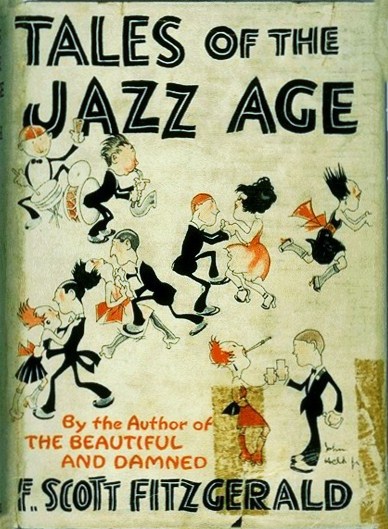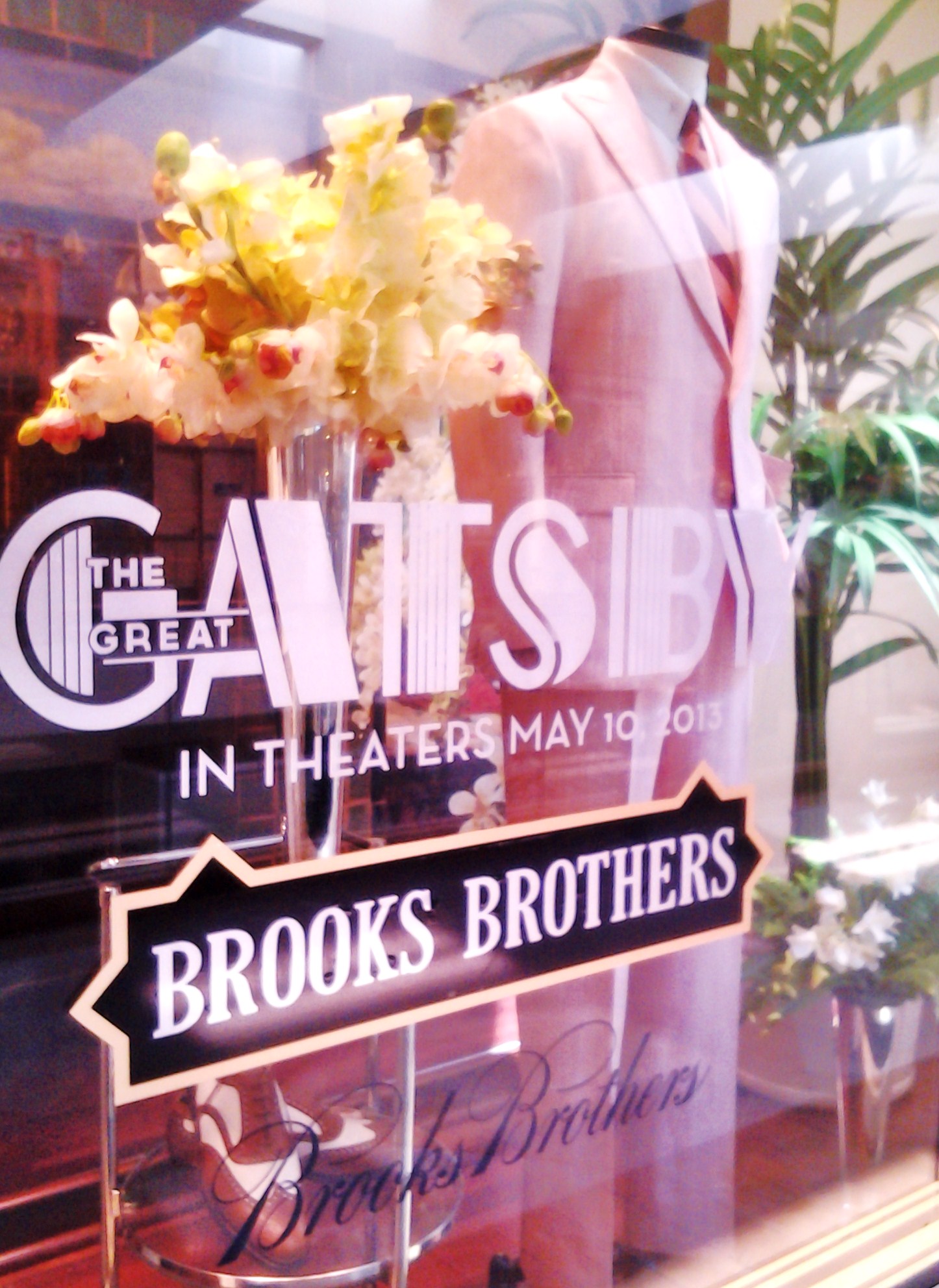 If one film has recently pinged my annoyingly particular radar screen with a single sparkly note, it is The Great Gatsby. Thrilled at the prospect of a big-budget feature finally dedicated to the art of storytelling, eschewing the long-overdone, over-hyped, cheesy SFX genre, I instantly started swinging my vintage Whiting & Davis handbag round my wrist in anticipation. Just as my tootsies started to join in the fun, my Mary Janes ready to Charleston, I learned Baz Luhrmann's The Great Gatsby of 2013 is in 3-D. Zowie!
If one film has recently pinged my annoyingly particular radar screen with a single sparkly note, it is The Great Gatsby. Thrilled at the prospect of a big-budget feature finally dedicated to the art of storytelling, eschewing the long-overdone, over-hyped, cheesy SFX genre, I instantly started swinging my vintage Whiting & Davis handbag round my wrist in anticipation. Just as my tootsies started to join in the fun, my Mary Janes ready to Charleston, I learned Baz Luhrmann's The Great Gatsby of 2013 is in 3-D. Zowie!
Be clear, yours truly is no Luddite. I adore and applaud progress, when necessary. If you've read my novels and regularly read my geek-culture articles and blog posts, you shall well know I embrace the Zeitgeist. Love me some Zeitgeist! Still, F. Scott Fitzgerald's literary masterpiece of self-doubt, jealousy, betrayal, murder, manipulation and heartbreak has zero need for 3-D confetti.
Still, how could a jazzy sweet patootie such as myself pass up this sumptuous, vicarious, visual fête of champagne, glitter, diamonds, feathers and fishnets? Surely the story remains in tact; certainly no main chacarters have been sidelined or their magnanimity diminished. So, I agreed to plop down my cabbage and see it, despite the threat of such aggressive progress ... then, I read Rex Reed's brutal and scorching review. Though I am not generally given to paying much mind to film reviews, Reed's warning left me aghast and faint-hearted, stunned by a gilded sense of foreboding. Reed proffers a glimpse into a film so ruthlessly bad that, were I to see it I might turn to stone, like a victim of Medusa, my face frozen in perpetual horror as a Duesenberg hood ornament flies at my powdered face. I had to rethink my decision to shell out said-cabbage. Then, happily, along came new information about the costume design.
The 1920s marked an age as pivotal and dynamic as our own technological age. America was shifting from an agricultural existence to an industrial one as feverishly and unabashedly as a drunken, desperate, last-hurrah, Labor Day dock party in the Hamptons. Single girls were moving from family farms to the big cities in droves, ready to pop their champagne corks and break free from the wasp-waist whalebone corsets and high-neck lace blousons of their Victorian and Edwardian grandmamas. No more milking the cows and darning Pa's socks. The Jazz Age was nigh and it was America's well-earned, Naughty Weekend: sex, jazz and, despite a decade-plus of Prohibition, booze. (Step off, 1960s. You old hippies never even came close.) It was as though we knew the Thirties were coming with it's Great Depression, Dust Bowl, dowdy Red Cross shoes and the distant knell of WWII. It was time to party and party hard. So, ask any twenty-something, what's the best way to party harder than your grandparents ever did, annoy your elders and distance yourself from your parents? Attitude, excessive booze and, of course, style.
and unabashedly as a drunken, desperate, last-hurrah, Labor Day dock party in the Hamptons. Single girls were moving from family farms to the big cities in droves, ready to pop their champagne corks and break free from the wasp-waist whalebone corsets and high-neck lace blousons of their Victorian and Edwardian grandmamas. No more milking the cows and darning Pa's socks. The Jazz Age was nigh and it was America's well-earned, Naughty Weekend: sex, jazz and, despite a decade-plus of Prohibition, booze. (Step off, 1960s. You old hippies never even came close.) It was as though we knew the Thirties were coming with it's Great Depression, Dust Bowl, dowdy Red Cross shoes and the distant knell of WWII. It was time to party and party hard. So, ask any twenty-something, what's the best way to party harder than your grandparents ever did, annoy your elders and distance yourself from your parents? Attitude, excessive booze and, of course, style.
By the Roaring Twenties, gone were the tight-laced, buttoned-up, sartorial standards of the wet smacks whom came before this Jazz Age of rowdy pips. Enter stage left: swishy fringe, fouffy feathers, dyed furs, beaded minis, overflowing accessories, unstructured waists, mannish bobs and scandalous hemlines showing off all those great getaway sticks capped with shiny kitten heels, clearly not cobbled for dour farm girls and stay-at-home bankers' wives. Hit the road, Gibson Girl. Hello, Dolly! The middle class was climbing down from the hay lofts and with their new lives came a desire for kippy threads. Brooks Brothers, already a hundred-year old establishment, was there to answer the call, even if their price points have never been solidly middle-class.
If anyone knows Jazz Age dressing, it's our American Brooks Brothers. If anyone knows flash, soiree style, it's the Italian atelier of Prada. If anyone knows production design and costuming it's frequent Luhrmann collaborator, fellow Aussie and BAFTA- and Oscar-winner Catherine Martin (Moulin Rouge, Romeo + Juliet, Strictly Ballroom). When I learned these powerhouses of the posh and panache were responsible for Luhrmann's eye-candy, it was clear I needed to, as I said, rethink this spectacle.
In an instant, I knew Brooks Brothers was involved. When striped, regatta blazers, straw boaters and striped ties make the scene, it's clear they're involved. In fact, the nearly-200-year old haberdasher has been involved from the get-go, even outfitting The Great Gatsby author F. Scott Fitzgerald himself, ordering directly from their catalogs throughout the Twenties. His devotion to the outfitters helped make popular various styles, including their signature button-down, attached-collar shirt.
Founded in New York City in 1818, the same year the White House reopened after having been torched by the Brits during the War of 1812, and the same year the U.S. Congress decided our flag would have thirteen red and white stripes and twenty stars, Brooks Brothers is America's oldest clothing retailer and first ready-to-wear emporium. Spanning nearly the entirety of our country's existence, Brooks Brothers is no drifter when it comes to bespoke clothing for the upper-crust, making history, notoriously as well as famously.
President Abraham Lincoln, a loyal Brooks Brothers customer, was bestowed a special coat upon his second inauguration, the lining embroidered with an eagle and the inscription "One Country, One Destiny". (In fact, Brooks Brothers has outfitted thirty-nine of our forty-four U.S. presidents. George W. Bush might be one of the hold-outs, opting for J. Press as his outfitter, another Old School, upscale, but Yale-founded, New England-based clothier.) Eerily, Lincoln was shot at Ford's Theater wearing that same coat two tragic weeks later. Still, life goes on and along the way, Brooks Brothers quietly held history's hand.
Charles Lindbergh, unable to carry much luggage on his transatlantic flight, borrowed a coat upon his Paris landing, a Brooks Brothers belonging to the American ambassador. Clark Gable wed an aristocrat in B.B., his custom suit of choice, as no one else could fit his impressive physique of a 44" chest/32" waist. Legend has it pop artist Andy Warhol spent his first paycheck on a B.B. No. 10, white button-down. Perhaps, most impressive of all, Kermit the Frog owns at least one tiny, bespoke, amphibious tuxedo.
 If you think Brooks Brothers is a bit blue-blood and starched-collar for this tacky and gauche film business, you are correct. Still, Brooks Brothers' vice-president of global relations, Arthur Wayne told Adweek, "We’re not a highly promotional brand. But, we do it when it feels right.” Considering Brooks Brothers was at the original party with Fitzgerald himself, one imagines it does feel right. Though they are also not usually known for film tie-ins, they are sporting a raw-ther nifty collection of summer togs for the lean of frame, beautiful of face and hearty of cabbage: Bright Young Things.
If you think Brooks Brothers is a bit blue-blood and starched-collar for this tacky and gauche film business, you are correct. Still, Brooks Brothers' vice-president of global relations, Arthur Wayne told Adweek, "We’re not a highly promotional brand. But, we do it when it feels right.” Considering Brooks Brothers was at the original party with Fitzgerald himself, one imagines it does feel right. Though they are also not usually known for film tie-ins, they are sporting a raw-ther nifty collection of summer togs for the lean of frame, beautiful of face and hearty of cabbage: Bright Young Things.
Where posh is concerned, Prada wrote the travel guide. Founded in 1913, Prada began its couture trek as a leather goods purveyor: steamer trunks, luggage, beauty cases, porte-monnaies, portmanteaux, handbags and a variety of luxury accessories. By 1919, just about the time Gatsby's sycophantic circle of friends were swinging from his chandeliers, Prada was appointed an official supplier to the Italian Royal Family.
As Egyptian travel became all the rage, thanks to Howard Carter, Lord Carnarvon and their 1922 discovery of Tutankhamun's tomb, Prada jewelry cases and resort bags saw action sailing up and down the Nile on Agatha Christie-style excursions. Queen Mary's polished decks were littered with Prada steamer trunks in the 1930s, many of those marked "P.O.S.H.": the abbreviation stamped on luggage belonging to passengers with top-flight rooms. What defines the best room on a cruise ship? The view, of course, sailing HMS Queen Mary in and out of Southampton and Dover: Port Outbound, Starboard Homebound, or P.O.S.H.
By 2012, four very posh gentleman donned their Jules Verneesque best as Prada reached back to Victoriana and embraced fashion's current obsession of steampunk. View Gary Oldman, Garrett Hedlund, Jamie Bell and Willem Dafoe in some very fetching, very attractive glad rags.
Before Brooks Brothers and Prada, the most recent posh designer to tackle the mighty task of Fitzgerald frippery was the legendary Ralph Lauren, dressing the ever-dapper, butter-and-egg man, Robert Redford in The Great Gatsby of 1974. Well done, Ralph. This time, Leonardo DiCaprio gets the swanky, onyx cufflink treatment, along with Tobey Maguire in shawl neck sweaters and deck shoes, looking a bit like he borrowed Father's cruise wear and unsure how to wear it. That could be the problem. One does not wear Brooks Brothers; one sports it. If one cannot, one should not.
According to more than a few critics, come awards-season, the special effects, acting and directing may just have to sit in the rumble seat of this Duesy. Brooks Brothers is driving Miss Daisy and Miuccia Prada is riding shotgun, with costume designer Catherine Martin sitting on her lap. This trifecta of fashion may be what pitches this pony over the finish line. To boot, whilst Jay-Z's hip-hop-infused Jazz Age soundtrack may be off-putting to purists, it seems a welcome addition to this dame. After all, modern-day hip-hop finds its roots in Twenties jazz and, considering the fashion may be the star of the show, one must have some high-kicking, free-swinging, jazz-hands tuneage to accompany those svelte Flappers and slick-haired Big Spenders, all togged to the bricks. As with many things in life, it really don't mean a thing if it ain't got that swing.
Yep, you shred it, Wheat. Looks like I just might have to hand over my cabbage to Mr. Luhrmann after all.
000


